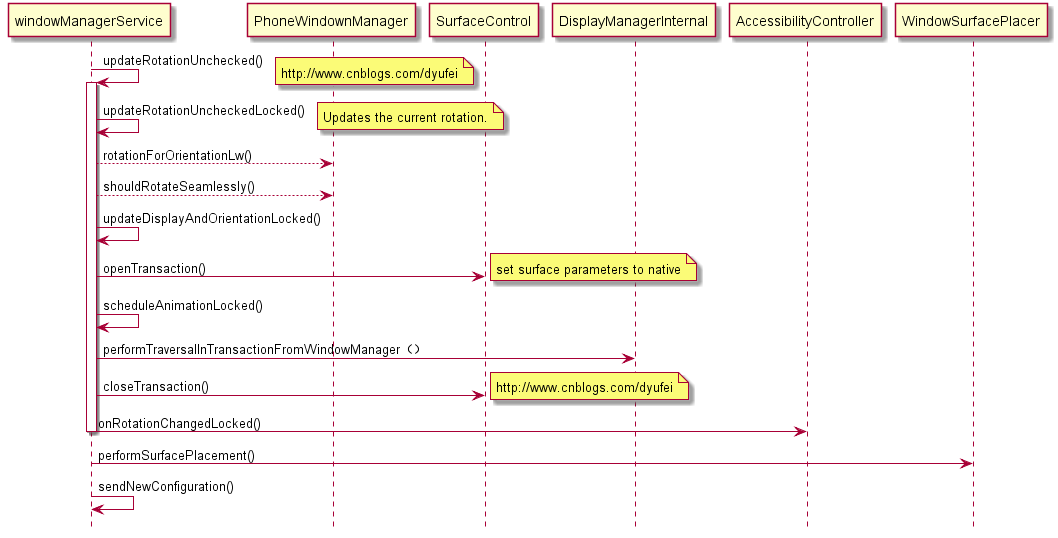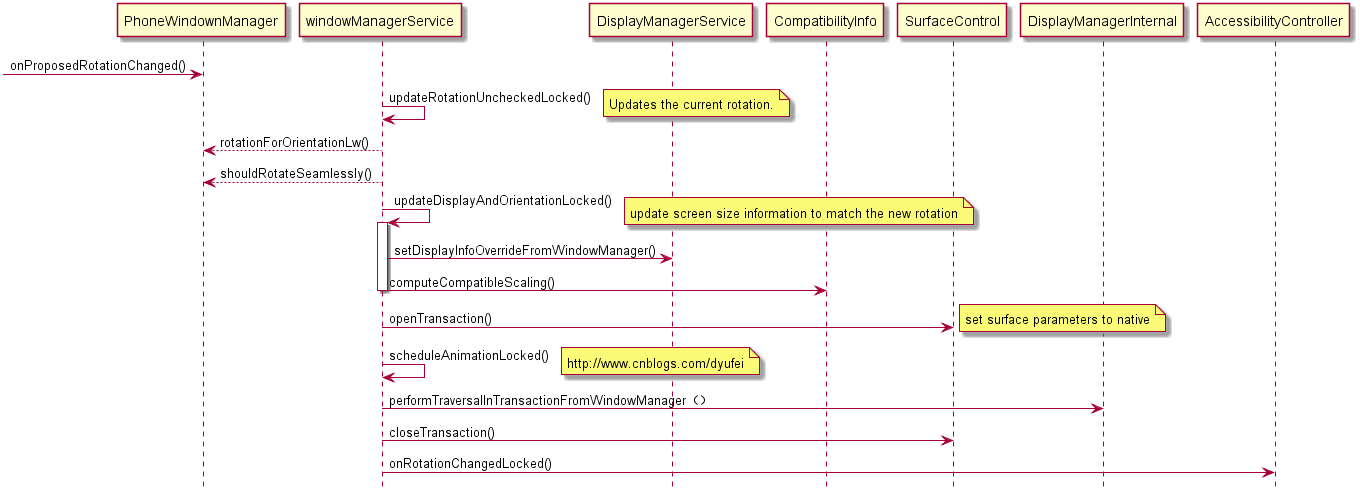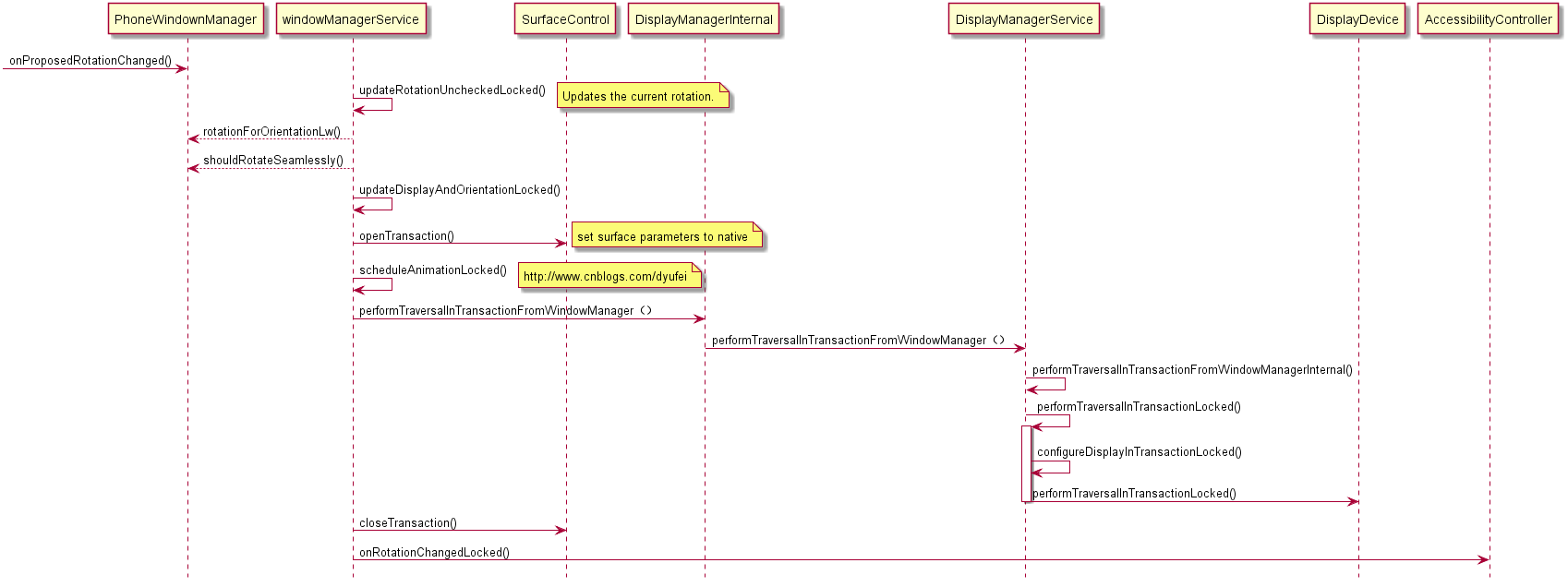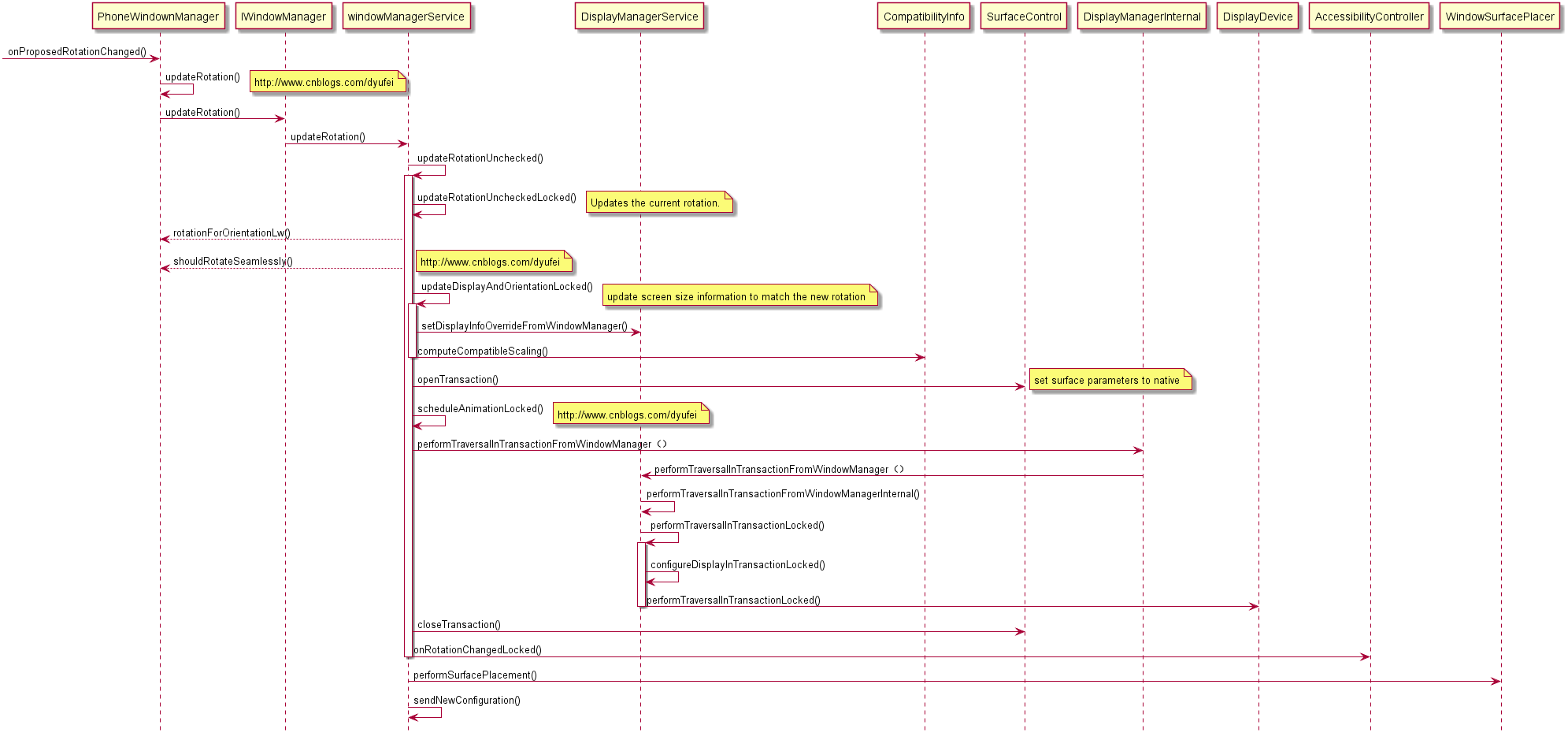Android 7.1 WindowManagerService 屏幕旋转流程分析 (二)
一、概述
从上篇【Android 7.1 屏幕旋转流程分析】知道实际的旋转由WindowManagerService来完成,这里接着上面具体详细展开。 调了三个函数完成了三件事,即首先调用updateRotationUncheckedLocked()更新rotation,然后调用performSurfacePlacement()做屏幕的绘制,最后调用sendNewConfiguration()发送Configuration变更事件。
本篇对updateRotationUncheckedLocked()详细展开,后面的系列会继续详细介绍剩余的部分。
public void updateRotationUnchecked(boolean alwaysSendConfiguration, boolean forceRelayout) {
if(DEBUG_ORIENTATION) Slog.v(TAG_WM, "updateRotationUnchecked("
+ "alwaysSendConfiguration=" + alwaysSendConfiguration + ")");
long origId = Binder.clearCallingIdentity();
boolean changed;
synchronized(mWindowMap) {
//(1)更新rotation
changed = updateRotationUncheckedLocked(false);
if (!changed || forceRelayout) {
getDefaultDisplayContentLocked().layoutNeeded = true;
//(2)做屏幕的绘制
mWindowPlacerLocked.performSurfacePlacement();
}
}
if (changed || alwaysSendConfiguration) {
//(3)发送Configuration变更事件
sendNewConfiguration();
}
Binder.restoreCallingIdentity(origId);
}

二、更新rotation
updateRotationUncheckedLocked()主要完成如下几件事:
A : 首先判断有下列情形的则返回false放弃更新rotation
(1)有延迟的Rotation尚未完成,即DeferredRotationPauseCount > 0
(2)上次旋转还没有完成旋转动画还在运行中,即screenRotationAnimation.isAnimating() == true
(3)旋转动画已完成但display还未unfrozen(display 还在Frozen状态)及 mDisplayFrozen == true
(4)display 不可用
B:获取设备方向
(PhoneWindowManager的rotationForOrientationLw()根据根据传感器数据计算转换为设备方向)和是否需要平滑(Seamlessly)旋转(PhoneWindowManager的shouldRotateSeamlessly()函数)如果Seamlessly则不能有旋转动画。
C:根据新的显示方向(Orientation)来更新DisplayInfo
D通过SurfaceControl.openTransaction()设置Surface参数
public boolean updateRotationUncheckedLocked(boolean inTransaction) {
if (mDeferredRotationPauseCount > 0) {
// Rotation updates have been paused temporarily. Defer the update until
// updates have been resumed.
if (DEBUG_ORIENTATION) Slog.v(TAG_WM, "Deferring rotation, rotation is paused.");
return false;
}
//如果上次的旋转动画还在运行中(即上次还未旋转完成则无需旋转,返回false)
ScreenRotationAnimation screenRotationAnimation =
mAnimator.getScreenRotationAnimationLocked(Display.DEFAULT_DISPLAY);
if (screenRotationAnimation != null && screenRotationAnimation.isAnimating()) {
// Rotation updates cannot be performed while the previous rotation change
// animation is still in progress. Skip this update. We will try updating
// again after the animation is finished and the display is unfrozen.
if (DEBUG_ORIENTATION) Slog.v(TAG_WM, "Deferring rotation, animation in progress.");
return false;
}
//display 尚未unfrozen
if (mDisplayFrozen) {
// Even if the screen rotation animation has finished (e.g. isAnimating
// returns false), there is still some time where we haven't yet unfrozen
// the display. We also need to abort rotation here.
if (DEBUG_ORIENTATION) Slog.v(TAG_WM, "Deferring rotation, still finishing previous rotation");
return false;
}
if (!mDisplayEnabled) {
// No point choosing a rotation if the display is not enabled.
if (DEBUG_ORIENTATION) Slog.v(TAG_WM, "Deferring rotation, display is not enabled.");
return false;
}
final DisplayContent displayContent = getDefaultDisplayContentLocked();
final WindowList windows = displayContent.getWindowList();
final int oldRotation = mRotation;
//获取设备方向(根据传感器数据计算转换为设备方向)
int rotation = mPolicy.rotationForOrientationLw(mLastOrientation, mRotation);
//获取rotateSeamlessly
boolean rotateSeamlessly = mPolicy.shouldRotateSeamlessly(oldRotation, rotation);
// 处理判断是否可以Seamlessly
if (rotateSeamlessly) {
for (int i = windows.size() - 1; i >= 0; i--) {
WindowState w = windows.get(i);
if (w.mSeamlesslyRotated) {
return false;
}
if (w.isChildWindow() & w.isVisibleNow() &&
!w.mWinAnimator.mSurfaceController.getTransformToDisplayInverse()) {
rotateSeamlessly = false;
}
}
}
boolean altOrientation = !mPolicy.rotationHasCompatibleMetricsLw(
mLastOrientation, rotation);
if (DEBUG_ORIENTATION) {
Slog.v(TAG_WM, "Selected orientation "
+ mLastOrientation + ", got rotation " + rotation
+ " which has " + (altOrientation ? "incompatible" : "compatible")
+ " metrics");
}
if (mRotation == rotation && mAltOrientation == altOrientation) {
// No change.
return false;
}
if (DEBUG_ORIENTATION) {
Slog.v(TAG_WM,
"Rotation changed to " + rotation + (altOrientation ? " (alt)" : "")
+ " from " + mRotation + (mAltOrientation ? " (alt)" : "")
+ ", lastOrientation=" + mLastOrientation);
}
mRotation = rotation;
mAltOrientation = altOrientation;
mPolicy.setRotationLw(mRotation);
mWindowsFreezingScreen = WINDOWS_FREEZING_SCREENS_ACTIVE;
//发送WINDOW_FREEZE_TIMEOUT消息
mH.removeMessages(H.WINDOW_FREEZE_TIMEOUT);
mH.sendEmptyMessageDelayed(H.WINDOW_FREEZE_TIMEOUT, WINDOW_FREEZE_TIMEOUT_DURATION);
mWaitingForConfig = true;
displayContent.layoutNeeded = true;
final int[] anim = new int[2];
if (displayContent.isDimming()) {
anim[0] = anim[1] = 0;
} else {
mPolicy.selectRotationAnimationLw(anim);
}
// 如果是Seamlessly则无旋转动画,因Seamlessly目前不支持旋转动画
if (!rotateSeamlessly) {
startFreezingDisplayLocked(inTransaction, anim[0], anim[1]);
// startFreezingDisplayLocked can reset the ScreenRotationAnimation.
screenRotationAnimation =
mAnimator.getScreenRotationAnimationLocked(Display.DEFAULT_DISPLAY);
} else {
// The screen rotation animation uses a screenshot to freeze the screen
// while windows resize underneath.
// When we are rotating seamlessly, we allow the elements to transition
// to their rotated state independently and without a freeze required.
screenRotationAnimation = null;
// We have to reset this in case a window was removed before it
// finished seamless rotation.
mSeamlessRotationCount = 0;
}
// We need to update our screen size information to match the new rotation. If the rotation
// has actually changed then this method will return true and, according to the comment at
// the top of the method, the caller is obligated to call computeNewConfigurationLocked().
// By updating the Display info here it will be available to
// computeScreenConfigurationLocked later.
//根据rotation 去更新DisplayInfo
updateDisplayAndOrientationLocked(mCurConfiguration.uiMode);
final DisplayInfo displayInfo = displayContent.getDisplayInfo();
if (!inTransaction) {
if (SHOW_TRANSACTIONS) {
Slog.i(TAG_WM, ">>> OPEN TRANSACTION setRotationUnchecked");
}
// 设置surface参数
SurfaceControl.openTransaction();
}
try {
// NOTE: We disable the rotation in the emulator because
// it doesn't support hardware OpenGL emulation yet.
if (CUSTOM_SCREEN_ROTATION && screenRotationAnimation != null
&& screenRotationAnimation.hasScreenshot()) {
if (screenRotationAnimation.setRotationInTransaction(
rotation, mFxSession,
MAX_ANIMATION_DURATION, getTransitionAnimationScaleLocked(),
displayInfo.logicalWidth, displayInfo.logicalHeight)) {
scheduleAnimationLocked();
}
}
if (rotateSeamlessly) {
for (int i = windows.size() - 1; i >= 0; i--) {
WindowState w = windows.get(i);
w.mWinAnimator.seamlesslyRotateWindow(oldRotation, mRotation);
}
}
mDisplayManagerInternal.performTraversalInTransactionFromWindowManager();
} finally {
if (!inTransaction) {
SurfaceControl.closeTransaction();
if (SHOW_LIGHT_TRANSACTIONS) {
Slog.i(TAG_WM, "<<< CLOSE TRANSACTION setRotationUnchecked");
}
}
}
for (int i = windows.size() - 1; i >= 0; i--) {
WindowState w = windows.get(i);
// Discard surface after orientation change, these can't be reused.
if (w.mAppToken != null) {
w.mAppToken.destroySavedSurfaces();
}
if (w.mHasSurface && !rotateSeamlessly) {
if (DEBUG_ORIENTATION) Slog.v(TAG_WM, "Set mOrientationChanging of " + w);
w.mOrientationChanging = true;
mWindowPlacerLocked.mOrientationChangeComplete = false;
w.mLastFreezeDuration = 0;
}
}
if (rotateSeamlessly) {
mH.removeMessages(H.SEAMLESS_ROTATION_TIMEOUT);
mH.sendEmptyMessageDelayed(H.SEAMLESS_ROTATION_TIMEOUT, SEAMLESS_ROTATION_TIMEOUT_DURATION);
}
for (int i=mRotationWatchers.size()-1; i>=0; i--) {
try {
mRotationWatchers.get(i).watcher.onRotationChanged(rotation);
} catch (RemoteException e) {
}
}
// TODO (multidisplay): Magnification is supported only for the default display.
// Announce rotation only if we will not animate as we already have the
// windows in final state. Otherwise, we make this call at the rotation end.
if (screenRotationAnimation == null && mAccessibilityController != null
&& displayContent.getDisplayId() == Display.DEFAULT_DISPLAY) {
mAccessibilityController.onRotationChangedLocked(getDefaultDisplayContentLocked(),rotation);
}
return true;
}

1)通过PhoneWindowManager获取orientation 和rotateSeamlessly
A:PhoneWindowManager的rotationForOrientationLw()
PhoneWindowManager的rotationForOrientationLw()根据传感器数据和各种场景和设置来更新preferredRotation 和orientation(注释比较详细,不赘述)
public int rotationForOrientationLw(int orientation, int lastRotation) {
if (mForceDefaultOrientation) {
return Surface.ROTATION_0;
}
synchronized (mLock) {
int sensorRotation = mOrientationListener.getProposedRotation(); // may be -1
if (sensorRotation < 0) {
sensorRotation = lastRotation;
}
final int preferredRotation;
//根据各种场景和设置来更新preferredRotation 和orientation
if (mLidState == LID_OPEN && mLidOpenRotation >= 0) {
// Ignore sensor when lid switch is open and rotation is forced.
preferredRotation = mLidOpenRotation;
} else if (mDockMode == Intent.EXTRA_DOCK_STATE_CAR
&& (mCarDockEnablesAccelerometer || mCarDockRotation >= 0)) {
// Ignore sensor when in car dock unless explicitly enabled.
// This case can override the behavior of NOSENSOR, and can also
// enable 180 degree rotation while docked.
preferredRotation = mCarDockEnablesAccelerometer
? sensorRotation : mCarDockRotation;
} else if ((mDockMode == Intent.EXTRA_DOCK_STATE_DESK
|| mDockMode == Intent.EXTRA_DOCK_STATE_LE_DESK
|| mDockMode == Intent.EXTRA_DOCK_STATE_HE_DESK)
&& (mDeskDockEnablesAccelerometer || mDeskDockRotation >= 0)) {
// Ignore sensor when in desk dock unless explicitly enabled.
// This case can override the behavior of NOSENSOR, and can also
// enable 180 degree rotation while docked.
preferredRotation = mDeskDockEnablesAccelerometer
? sensorRotation : mDeskDockRotation;
} else if (mHdmiPlugged && mDemoHdmiRotationLock) {
// Ignore sensor when plugged into HDMI when demo HDMI rotation lock enabled.
// Note that the dock orientation overrides the HDMI orientation.
preferredRotation = mDemoHdmiRotation;
} else if (mHdmiPlugged && mDockMode == Intent.EXTRA_DOCK_STATE_UNDOCKED
&& mUndockedHdmiRotation >= 0) {
// Ignore sensor when plugged into HDMI and an undocked orientation has
// been specified in the configuration (only for legacy devices without
// full multi-display support).
// Note that the dock orientation overrides the HDMI orientation.
preferredRotation = mUndockedHdmiRotation;
} else if (mDemoRotationLock) {
// Ignore sensor when demo rotation lock is enabled.
// Note that the dock orientation and HDMI rotation lock override this.
preferredRotation = mDemoRotation;
} else if (orientation == ActivityInfo.SCREEN_ORIENTATION_LOCKED) {
// Application just wants to remain locked in the last rotation.
preferredRotation = lastRotation;
} else if (!mSupportAutoRotation) {
// If we don't support auto-rotation then bail out here and ignore
// the sensor and any rotation lock settings.
preferredRotation = -1;
} else if ((mUserRotationMode == WindowManagerPolicy.USER_ROTATION_FREE
&& (orientation == ActivityInfo.SCREEN_ORIENTATION_USER
|| orientation == ActivityInfo.SCREEN_ORIENTATION_UNSPECIFIED
|| orientation == ActivityInfo.SCREEN_ORIENTATION_USER_LANDSCAPE
|| orientation == ActivityInfo.SCREEN_ORIENTATION_USER_PORTRAIT
|| orientation == ActivityInfo.SCREEN_ORIENTATION_FULL_USER))
|| orientation == ActivityInfo.SCREEN_ORIENTATION_SENSOR
|| orientation == ActivityInfo.SCREEN_ORIENTATION_FULL_SENSOR
|| orientation == ActivityInfo.SCREEN_ORIENTATION_SENSOR_LANDSCAPE
|| orientation == ActivityInfo.SCREEN_ORIENTATION_SENSOR_PORTRAIT) {
// Otherwise, use sensor only if requested by the application or enabled
// by default for USER or UNSPECIFIED modes. Does not apply to NOSENSOR.
if (mAllowAllRotations < 0) {
// Can't read this during init() because the context doesn't
// have display metrics at that time so we cannot determine
// tablet vs. phone then.
mAllowAllRotations = mContext.getResources().getBoolean(
com.android.internal.R.bool.config_allowAllRotations) ? 1 : 0;
}
if (sensorRotation != Surface.ROTATION_180
|| mAllowAllRotations == 1
|| orientation == ActivityInfo.SCREEN_ORIENTATION_FULL_SENSOR
|| orientation == ActivityInfo.SCREEN_ORIENTATION_FULL_USER) {
preferredRotation = sensorRotation;
} else {
preferredRotation = lastRotation;
}
} else if (mUserRotationMode == WindowManagerPolicy.USER_ROTATION_LOCKED
&& orientation != ActivityInfo.SCREEN_ORIENTATION_NOSENSOR) {
// Apply rotation lock. Does not apply to NOSENSOR.
// The idea is that the user rotation expresses a weak preference for the direction
// of gravity and as NOSENSOR is never affected by gravity, then neither should
// NOSENSOR be affected by rotation lock (although it will be affected by docks).
preferredRotation = mUserRotation;
} else {
// No overriding preference.
// We will do exactly what the application asked us to do.
preferredRotation = -1;
}
switch (orientation) {
case ActivityInfo.SCREEN_ORIENTATION_PORTRAIT:
// Return portrait unless overridden.
if (isAnyPortrait(preferredRotation)) {
return preferredRotation;
}
return mPortraitRotation;
case ActivityInfo.SCREEN_ORIENTATION_LANDSCAPE:
// Return landscape unless overridden.
if (isLandscapeOrSeascape(preferredRotation)) {
return preferredRotation;
}
return mLandscapeRotation;
case ActivityInfo.SCREEN_ORIENTATION_REVERSE_PORTRAIT:
// Return reverse portrait unless overridden.
if (isAnyPortrait(preferredRotation)) {
return preferredRotation;
}
return mUpsideDownRotation;
case ActivityInfo.SCREEN_ORIENTATION_REVERSE_LANDSCAPE:
// Return seascape unless overridden.
if (isLandscapeOrSeascape(preferredRotation)) {
return preferredRotation;
}
return mSeascapeRotation;
case ActivityInfo.SCREEN_ORIENTATION_SENSOR_LANDSCAPE:
case ActivityInfo.SCREEN_ORIENTATION_USER_LANDSCAPE:
// Return either landscape rotation.
if (isLandscapeOrSeascape(preferredRotation)) {
return preferredRotation;
}
if (isLandscapeOrSeascape(lastRotation)) {
return lastRotation;
}
return mLandscapeRotation;
case ActivityInfo.SCREEN_ORIENTATION_SENSOR_PORTRAIT:
case ActivityInfo.SCREEN_ORIENTATION_USER_PORTRAIT:
// Return either portrait rotation.
if (isAnyPortrait(preferredRotation)) {
return preferredRotation;
}
if (isAnyPortrait(lastRotation)) {
return lastRotation;
}
return mPortraitRotation;
default:
// For USER, UNSPECIFIED, NOSENSOR, SENSOR and FULL_SENSOR,
// just return the preferred orientation we already calculated.
if (preferredRotation >= 0) {
return preferredRotation;
}
return Surface.ROTATION_0;
}
}
}
B: shouldRotateSeamlessly()
判断是否需要平滑(Seamlessly)旋转,目前仅 top window且为fullscreen 状态时才会返回true,其他均为false,因为Seamlessly要求冻结Surface的各种状态并且影响旋转动画效果,所以此状态时不支持旋转动画。所以这种状态支持的场景也仅限于此。了解一下即可。
public boolean shouldRotateSeamlessly(int oldRotation, int newRotation) {
if (oldRotation == mUpsideDownRotation || newRotation == mUpsideDownRotation) {
return false;
}
int delta = newRotation - oldRotation;
if (delta < 0) delta += 4;
if (delta == Surface.ROTATION_180) {
return false;
}
final WindowState w = mTopFullscreenOpaqueWindowState;
if (w != mFocusedWindow) {
return false;
}
if (w != null && !w.isAnimatingLw() &&
((w.getAttrs().rotationAnimation == ROTATION_ANIMATION_JUMPCUT) ||
(w.getAttrs().rotationAnimation == ROTATION_ANIMATION_SEAMLESS))) {
return true;
}
return false;
}
2)更新显示信息(DisplayInfo)
根据新的显示方向(Orientation)来更新DisplayInfo,然后通过setDisplayInfoOverrideFromWindowManager()来更新显示设备最后计算frame Rect 给应用来做缩放用。
DisplayInfo updateDisplayAndOrientationLocked(int uiMode) {
// TODO(multidisplay): For now, apply Configuration to main screen only.
final DisplayContent displayContent = getDefaultDisplayContentLocked();
// Use the effective "visual" dimensions based on current rotation
final boolean rotated = (mRotation == Surface.ROTATION_90
|| mRotation == Surface.ROTATION_270);
final int realdw = rotated ?
displayContent.mBaseDisplayHeight : displayContent.mBaseDisplayWidth;
final int realdh = rotated ?
displayContent.mBaseDisplayWidth : displayContent.mBaseDisplayHeight;
int dw = realdw;
int dh = realdh;
if (mAltOrientation) {
if (realdw > realdh) {
// Turn landscape into portrait.
int maxw = (int)(realdh/1.3f);
if (maxw < realdw) {
dw = maxw;
}
} else {
// Turn portrait into landscape.
int maxh = (int)(realdw/1.3f);
if (maxh < realdh) {
dh = maxh;
}
}
}
// Update application display metrics.
final int appWidth = mPolicy.getNonDecorDisplayWidth(dw, dh, mRotation, uiMode);
final int appHeight = mPolicy.getNonDecorDisplayHeight(dw, dh, mRotation, uiMode);
final DisplayInfo displayInfo = displayContent.getDisplayInfo();
displayInfo.rotation = mRotation;
displayInfo.logicalWidth = dw;
displayInfo.logicalHeight = dh;
displayInfo.logicalDensityDpi = displayContent.mBaseDisplayDensity;
displayInfo.appWidth = appWidth;
displayInfo.appHeight = appHeight;
displayInfo.getLogicalMetrics(mRealDisplayMetrics,
CompatibilityInfo.DEFAULT_COMPATIBILITY_INFO, null);
displayInfo.getAppMetrics(mDisplayMetrics);
if (displayContent.mDisplayScalingDisabled) {
displayInfo.flags |= Display.FLAG_SCALING_DISABLED;
} else {
displayInfo.flags &= ~Display.FLAG_SCALING_DISABLED;
}
mDisplayManagerInternal.setDisplayInfoOverrideFromWindowManager(
displayContent.getDisplayId(), displayInfo);
displayContent.mBaseDisplayRect.set(0, 0, dw, dh);
if (false) {
Slog.i(TAG_WM, "Set app display size: " + appWidth + " x " + appHeight);
}
mCompatibleScreenScale = CompatibilityInfo.computeCompatibleScaling(mDisplayMetrics,
mCompatDisplayMetrics);
return displayInfo;
}
A: DisplayManagerService.setDisplayInfoOverrideFromWindowManager()
window manager 通过此函数来更新逻辑显示设备(logical display)的大小变化和一些特性的变更。
首先通过sendDisplayEventLocked()会发送一个MSG_DELIVER_DISPLAY_EVENT消息然后通过,然后调用scheduleTraversalLocked()发送MSG_REQUEST_TRAVERSAL消息请求surface 和display处理变更请求。
public void setDisplayInfoOverrideFromWindowManager(int displayId, DisplayInfo info) {
setDisplayInfoOverrideFromWindowManagerInternal(displayId, info);
}
private void setDisplayInfoOverrideFromWindowManagerInternal(int displayId, DisplayInfo info) {
synchronized (mSyncRoot) {
LogicalDisplay display = mLogicalDisplays.get(displayId);
if (display != null) {
if (display.setDisplayInfoOverrideFromWindowManagerLocked(info)) {
//发送MSG_DELIVER_DISPLAY_EVENT消息
sendDisplayEventLocked(displayId, DisplayManagerGlobal.EVENT_DISPLAY_CHANGED);
//发送MSG_REQUEST_TRAVERSAL消息
scheduleTraversalLocked(false);
}
}
}
}
private void sendDisplayEventLocked(int displayId, int event) {
Message msg = mHandler.obtainMessage(MSG_DELIVER_DISPLAY_EVENT, displayId, event);
mHandler.sendMessage(msg);
}
发送MSG_REQUEST_TRAVERSAL消息请求,稍后由surface 和display处理变更请求。这样处理是为了异步执行。
private void scheduleTraversalLocked(boolean inTraversal) {
if (!mPendingTraversal && mWindowManagerInternal != null) {
mPendingTraversal = true;
if (!inTraversal) {
mHandler.sendEmptyMessage(MSG_REQUEST_TRAVERSAL);
}
}
}
B: computeCompatibleScaling() 计算frame Rect来供应用做缩放
public static float computeCompatibleScaling(DisplayMetrics dm, DisplayMetrics outDm) {
final int width = dm.noncompatWidthPixels;
final int height = dm.noncompatHeightPixels;
int shortSize, longSize;
if (width < height) {
shortSize = width;
longSize = height;
} else {
shortSize = height;
longSize = width;
}
int newShortSize = (int)(DEFAULT_NORMAL_SHORT_DIMENSION * dm.density + 0.5f);
float aspect = ((float)longSize) / shortSize;
if (aspect > MAXIMUM_ASPECT_RATIO) {
aspect = MAXIMUM_ASPECT_RATIO;
}
int newLongSize = (int)(newShortSize * aspect + 0.5f);
int newWidth, newHeight;
if (width < height) {
newWidth = newShortSize;
newHeight = newLongSize;
} else {
newWidth = newLongSize;
newHeight = newShortSize;
}
float sw = width/(float)newWidth;
float sh = height/(float)newHeight;
float scale = sw < sh ? sw : sh;
if (scale < 1) {
scale = 1;
}
if (outDm != null) {
outDm.widthPixels = newWidth;
outDm.heightPixels = newHeight;
}
return scale;
}

3)DisplayManagerService的performTraversalInTransactionFromWindowManager()
public void performTraversalInTransactionFromWindowManager() {
performTraversalInTransactionFromWindowManagerInternal();
}
private void performTraversalInTransactionFromWindowManagerInternal() {
synchronized (mSyncRoot) {
if (!mPendingTraversal) {
return;
}
mPendingTraversal = false;
performTraversalInTransactionLocked();
}
// List is self-synchronized copy-on-write.
for (DisplayTransactionListener listener : mDisplayTransactionListeners) {
listener.onDisplayTransaction();
}
}
private void performTraversalInTransactionLocked() {
// Clear all viewports before configuring displays so that we can keep
// track of which ones we have configured.
clearViewportsLocked();
// Configure each display device.
final int count = mDisplayDevices.size();
for (int i = 0; i < count; i++) {
DisplayDevice device = mDisplayDevices.get(i);
configureDisplayInTransactionLocked(device);
device.performTraversalInTransactionLocked();
}
// Tell the input system about these new viewports.
if (mInputManagerInternal != null) {
mHandler.sendEmptyMessage(MSG_UPDATE_VIEWPORT);
}
}
private void configureDisplayInTransactionLocked(DisplayDevice device) {
final DisplayDeviceInfo info = device.getDisplayDeviceInfoLocked();
final boolean ownContent = (info.flags & DisplayDeviceInfo.FLAG_OWN_CONTENT_ONLY) != 0;
// Find the logical display that the display device is showing.
// Certain displays only ever show their own content.
LogicalDisplay display = findLogicalDisplayForDeviceLocked(device);
if (!ownContent) {
if (display != null && !display.hasContentLocked()) {
// If the display does not have any content of its own, then
// automatically mirror the default logical display contents.
display = null;
}
if (display == null) {
display = mLogicalDisplays.get(Display.DEFAULT_DISPLAY);
}
}
// Apply the logical display configuration to the display device.
if (display == null) {
// TODO: no logical display for the device, blank it
Slog.w(TAG, "Missing logical display to use for physical display device: "
+ device.getDisplayDeviceInfoLocked());
return;
}
display.configureDisplayInTransactionLocked(device, info.state == Display.STATE_OFF);
// Update the viewports if needed.
if (!mDefaultViewport.valid
&& (info.flags & DisplayDeviceInfo.FLAG_DEFAULT_DISPLAY) != 0) {
setViewportLocked(mDefaultViewport, display, device);
}
if (!mExternalTouchViewport.valid
&& info.touch == DisplayDeviceInfo.TOUCH_EXTERNAL) {
setViewportLocked(mExternalTouchViewport, display, device);
}
}

4)总结

Android 7.1 WindowManagerService 屏幕旋转流程分析 (二)的更多相关文章
- Android 7.1 WindowManagerService 屏幕旋转流程分析 (三)
三.屏幕的绘制 performSurfacePlacement()函数来触发window的绘制,这里最大的循环次数是6,当然一般不会到最大次数就会被Scheduled. final void perf ...
- Android 7.1 ActivityManagerService 屏幕旋转流程分析 (四)
四.Activity的更新(旋转) sendNewConfiguration()会调用到ActivityManagerService的updateConfiguration()来update Conf ...
- Android 7.1 屏幕旋转流程分析
Android 7.1 屏幕旋转流程分析 一.概述 Android屏幕的旋转在framework主要涉及到三个类,结构如图 PhoneWindowManager:为屏幕的横竖屏转换的管理类. Wi ...
- 【转】如何在 Android 程序中禁止屏幕旋转和重启Activity
原文网址:http://www.cnblogs.com/bluestorm/p/3665890.html 禁止屏幕随手机旋转变化 有时候我们希望让一个程序的界面始终保持在一个方向,不随手机方向旋转而变 ...
- 如何在 Android 程序中禁止屏幕旋转和重启Activity
禁止屏幕随手机旋转变化 有时候我们希望让一个程序的界面始终保持在一个方向,不随手机方向旋转而变化:在AndroidManifest.xml的每一个需要禁止转向的Activity配置中加入android ...
- Android笔记--View绘制流程源码分析(二)
Android笔记--View绘制流程源码分析二 通过上一篇View绘制流程源码分析一可以知晓整个绘制流程之前,在activity启动过程中: Window的建立(activit.attach生成), ...
- Android 4.4 音量调节流程分析(二)
之前在Android 4.4 音量调节流程分析(一)里已经有简单的分析音量控制的流程,今天想接着继续分析下音量大小计算的方法.对于任一播放文件而言其本身都有着固定大小的音量Volume_Max,而在A ...
- Android系统分析之运营商显示流程分析之运营商信息的读取流程二
运营商显示流程分析之运营商信息的读取流程 一. SIM卡运营商信息的读取 从前面的 运营商信息的获取和赋值 可以知道SIM卡运营商的赋值最终是在 SIMRecords 中完成的, 而SIM卡信息的相关 ...
- 【Android】11.3 屏幕旋转和场景变换过程中GridView的呈现
分类:C#.Android.VS2015: 创建日期:2016-02-21 一.简介 实际上,对于布局文件中的View来说,大多数情况下,Android都会自动保存这些状态,并不需要我们都去处理它.这 ...
随机推荐
- Flex布局:实现左右两列自伸缩撑满效果的
目前测试支持的浏览器: 兼容IE10及以上.Chrom.Firefox浏览器. 假如考虑IE10以下浏览器,可以考虑其他写法. 话不多说,上代码: <div style="back ...
- Redis的各项功能解决了哪些问题?
先看一下Redis是一个什么东西.官方简介解释到:Redis是一个基于BSD开源的项目,是一个把结构化的数据放在内存中的一个存储系统,你可以把它作为数据库,缓存和消息中间件来使用.同时支持string ...
- 透过浏览器看HTTP缓存[转载]
http://www.admin10000.com/document/6299.html 作为前端开发人员,对于我们的站点或应用的缓存机制我们能做的似乎不多,但这些却是与我们关注的性能息息相关 ...
- 关于viewports 设备像素比 密度
首先追溯到像素,第一个麻烦事像素的总量问题,同样的大小的屏幕像素可以差很远,像素大小更小的导致内容也变小 在小屏幕上如果展示巨大的桌面网页,诺基亚的做法是首先载入完整的桌面网页,然后缩放至设备屏幕 ...
- 使用SuperSocket打造逾10万长连接的Socket服务
SuperSocket 是一个轻量级, 跨平台而且可扩展的 .Net/Mono Socket 服务器程序框架.你无须了解如何使用 Socket, 如何维护 Socket 连接和 Socket 如何工作 ...
- 学习笔记-----php搭建用户管理系统
后台:php,数据库:mysql,前端:html,css,js; 主要页面介绍: 1.php连接数据库后台,读取数据并将其以表格的形式显示,并且有添加,编辑,删除,分页等功能: 2.php用于添加用户 ...
- Java_数据交换_fastJSON_01_用法入门
一.用法 1.序列化—将Object转为Json对象 Object data=JSON.toJSON( MyObject ); 注:本文的Object可以是Map.List.javaBean等 需求: ...
- 浅谈Verilog HDL代码编写风格
消失了好久,没有写文章,也没有做笔记,因为最近再赶一个比赛,时间很紧,昨天周六终于结束了,所以趁着周末这会儿有时间,写点东西,记录下来.首先我学习FPGA才一年多,我知道自己没有资格谈论一些比较深层次 ...
- 学习cordic算法所得(流水线结构、Verilog标准)
最近学习cordic算法,并利用FPGA实现,在整个学习过程中,对cordic算法原理.FPGA中流水线设计.Verilog标准有了更加深刻的理解. 首先,cordic算法的基本思想是通过一系列固定的 ...
- java-基础-泛型
java泛型通配符问题. java中的泛型基本用法参考<java编程思想>第四版 p.353 java泛型中比较难理解的主要是类型擦除和通配符相关. 1.类型擦除 在编译期间,类型 ...
